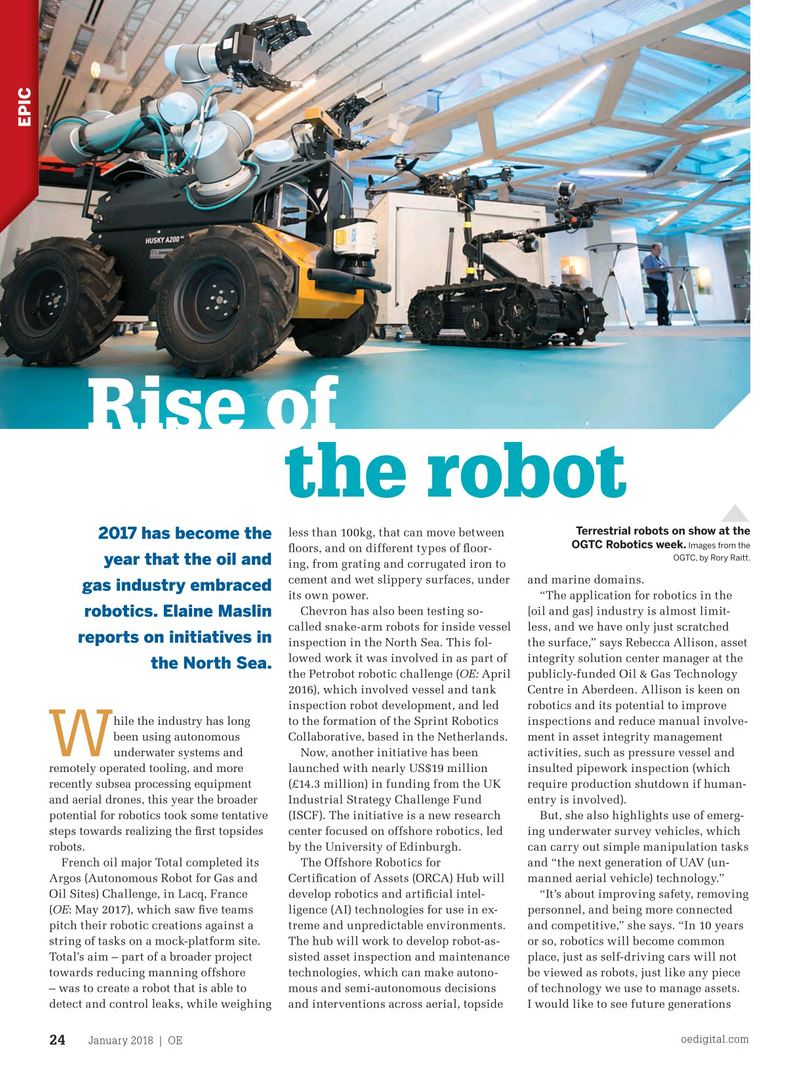
Page 22: of Offshore Engineer Magazine (Jan/Feb 2018)
Read this page in Pdf, Flash or Html5 edition of Jan/Feb 2018 Offshore Engineer Magazine
EPIC
Rise of the robot
Terrestrial robots on show at the less than 100kg, that can move between 2017 has become the
OGTC Robotics week. Images from the ? oors, and on different types of ? oor-
OGTC, by Rory Raitt.
year that the oil and ing, from grating and corrugated iron to cement and wet slippery surfaces, under and marine domains. gas industry embraced its own power. “The application for robotics in the
Chevron has also been testing so- [oil and gas] industry is almost limit- robotics. Elaine Maslin called snake-arm robots for inside vessel less, and we have only just scratched reports on initiatives in inspection in the North Sea. This fol- the surface,” says Rebecca Allison, asset lowed work it was involved in as part of integrity solution center manager at the the North Sea.
the Petrobot robotic challenge (OE: April publicly-funded Oil & Gas Technology 2016), which involved vessel and tank Centre in Aberdeen. Allison is keen on inspection robot development, and led robotics and its potential to improve hile the industry has long to the formation of the Sprint Robotics inspections and reduce manual involve- been using autonomous Collaborative, based in the Netherlands. ment in asset integrity management
W underwater systems and Now, another initiative has been activities, such as pressure vessel and remotely operated tooling, and more launched with nearly US$19 million insulted pipework inspection (which recently subsea processing equipment (£14.3 million) in funding from the UK require production shutdown if human- and aerial drones, this year the broader Industrial Strategy Challenge Fund entry is involved). potential for robotics took some tentative (ISCF). The initiative is a new research But, she also highlights use of emerg- steps towards realizing the ? rst topsides center focused on offshore robotics, led ing underwater survey vehicles, which robots. by the University of Edinburgh. can carry out simple manipulation tasks
French oil major Total completed its The Offshore Robotics for and “the next generation of UAV (un-
Argos (Autonomous Robot for Gas and Certi? cation of Assets (ORCA) Hub will manned aerial vehicle) technology.”
Oil Sites) Challenge, in Lacq, France develop robotics and arti? cial intel- “It’s about improving safety, removing (OE: May 2017), which saw ? ve teams ligence (AI) technologies for use in ex- personnel, and being more connected pitch their robotic creations against a treme and unpredictable environments. and competitive,” she says. “In 10 years string of tasks on a mock-platform site. The hub will work to develop robot-as- or so, robotics will become common
Total’s aim – part of a broader project sisted asset inspection and maintenance place, just as self-driving cars will not towards reducing manning offshore technologies, which can make autono- be viewed as robots, just like any piece – was to create a robot that is able to mous and semi-autonomous decisions of technology we use to manage assets. detect and control leaks, while weighing and interventions across aerial, topside I would like to see future generations oedigital.com
January 2018 | OE 24 024_OE0118_EPIC1_Robotics.indd 24 12/27/17 4:02 PM

 21
21

 23
23